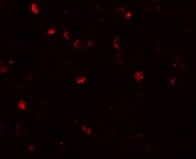Anti-TMEM16B antibody (ab91573)
Key features and details
- Rabbit polyclonal to TMEM16B
- Suitable for: ICC/IF, WB, IHC-P
- Reacts with: Human
- Isotype: IgG
Overview
-
Product name
Anti-TMEM16B antibody
See all TMEM16B primary antibodies -
Description
Rabbit polyclonal to TMEM16B -
Host species
Rabbit -
Specificity
This antibody will not cross-react with TMEM16A. -
Tested applications
Suitable for: ICC/IF, WB, IHC-Pmore details -
Species reactivity
Reacts with: Human -
Immunogen
Synthetic peptide corresponding to Human TMEM16B (N terminal).
Database link: Q9NQ90 -
General notes
The Life Science industry has been in the grips of a reproducibility crisis for a number of years. Abcam is leading the way in addressing this with our range of recombinant monoclonal antibodies and knockout edited cell lines for gold-standard validation. Please check that this product meets your needs before purchasing.
If you have any questions, special requirements or concerns, please send us an inquiry and/or contact our Support team ahead of purchase. Recommended alternatives for this product can be found below, along with publications, customer reviews and Q&As
Properties
-
Form
Liquid -
Storage instructions
Shipped at 4°C. Store at +4°C short term (1-2 weeks). Store at +4°C. -
Storage buffer
pH: 7.2
Preservative: 0.02% Sodium azide
Constituent: PBS -
 Concentration information loading...
Concentration information loading... -
Purity
Immunogen affinity purified -
Clonality
Polyclonal -
Isotype
IgG -
Research areas
Images
-
 Immunohistochemistry (Formalin/PFA-fixed paraffin-embedded sections) - Anti-TMEM16B antibody (ab91573)
Immunohistochemistry (Formalin/PFA-fixed paraffin-embedded sections) - Anti-TMEM16B antibody (ab91573)Immunohistochemical analysis of human brain tissue labelling TMEM16B with ab91573 at 5 ug/mL.
-
All lanes : Anti-TMEM16B antibody (ab91573) at 2 µg/ml
All lanes : Human small intestine tissue lysate
Predicted band size: 110 kDa
Observed band size: 107 kDa why is the actual band size different from the predicted?
-
Immunofluorescence of TMEM16B in Human Brain cells using ab91573 at 20 ug/ml.
-
Lane 1 : Anti-TMEM16B antibody (ab91573) at 1 µg/ml
Lane 2 : Anti-TMEM16B antibody (ab91573) at 2 µg/ml
All lanes : Rat brain tissue lysate
Lysates/proteins at 15 µg per lane.
Predicted band size: 110 kDa
The lower molecular weight band may represent one of the 3 isoforms of this protein which are known to exist, or a posttranslational modification.













